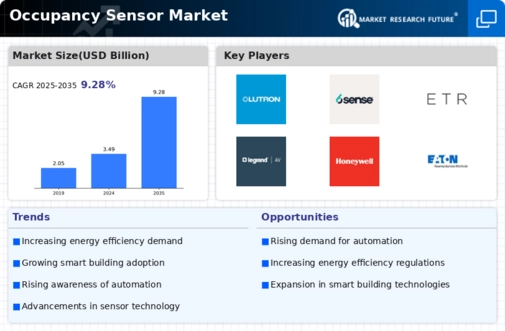Growing Demand for Energy Efficiency
The Global Occupancy Sensor Market Industry is experiencing a notable surge in demand for energy-efficient solutions. As organizations and governments increasingly prioritize sustainability, occupancy sensors are becoming essential for reducing energy consumption in commercial and residential buildings. These sensors optimize lighting and HVAC systems by ensuring that energy is used only when spaces are occupied. In 2024, the market is projected to reach 3.49 USD Billion, reflecting a growing recognition of the importance of energy efficiency. This trend is expected to continue, with the market potentially expanding to 9.28 USD Billion by 2035, indicating a robust compound annual growth rate (CAGR) of 9.3% from 2025 to 2035.
Integration of Smart Home Technologies
The integration of smart home technologies is a prominent factor influencing the Global Occupancy Sensor Market Industry. As consumers increasingly adopt smart home devices, the demand for occupancy sensors is rising, driven by their ability to enhance home automation and energy management. Occupancy sensors are being integrated into various smart home systems, allowing for automated lighting, heating, and security features based on real-time occupancy data. This trend is likely to propel market growth, with the market projected to reach 3.49 USD Billion in 2024 and potentially expanding to 9.28 USD Billion by 2035, reflecting a growing consumer preference for interconnected smart home solutions.
Technological Advancements in Sensor Technology
Technological advancements are significantly influencing the Global Occupancy Sensor Market Industry. Innovations in sensor technology, such as the integration of IoT capabilities and enhanced motion detection algorithms, are driving the adoption of occupancy sensors across various sectors. These advancements enable more accurate occupancy detection and improved user experiences. For instance, smart building technologies are increasingly incorporating occupancy sensors to automate lighting and climate control, thereby enhancing operational efficiency. As these technologies evolve, they are likely to attract more investments, further propelling market growth and potentially leading to a market valuation of 9.28 USD Billion by 2035.
Rising Awareness of Workplace Safety and Comfort
The rising awareness of workplace safety and comfort is significantly impacting the Global Occupancy Sensor Market Industry. Organizations are increasingly recognizing the importance of creating safe and comfortable environments for employees, which includes optimizing lighting and climate control based on occupancy. Occupancy sensors play a vital role in achieving this by ensuring that spaces are adequately lit and ventilated only when occupied. This focus on employee well-being is driving the demand for occupancy sensors in commercial spaces, contributing to the market's growth trajectory. As a result, the market is anticipated to reach 3.49 USD Billion in 2024, with expectations of further expansion to 9.28 USD Billion by 2035.
Regulatory Support for Smart Building Initiatives
Regulatory support for smart building initiatives is a crucial driver for the Global Occupancy Sensor Market Industry. Governments worldwide are implementing policies and incentives to promote the adoption of smart technologies in buildings, which include occupancy sensors. These regulations often focus on energy efficiency and sustainability, encouraging building owners to invest in advanced technologies. For example, various energy codes and standards mandate the use of occupancy sensors in commercial buildings to minimize energy waste. This regulatory environment is expected to foster market growth, contributing to a projected market size of 3.49 USD Billion in 2024 and a potential increase to 9.28 USD Billion by 2035.

























Leave a Comment